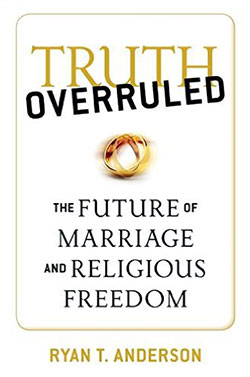Truth Overruled makes reasoned case for traditional marriage, religious liberty
Reviewed by Sean Gallagher
 Last June, the U.S. Supreme Court struck down state laws and constitutional amendments across the country that defined marriage as the union of one man and one woman.
Last June, the U.S. Supreme Court struck down state laws and constitutional amendments across the country that defined marriage as the union of one man and one woman.
On the surface, its Obergefell v. Hodges ruling seems to have ended discussion in the public square of the nature of marriage.
In many ways, however, the 5-4 decision has also served to broaden and deepen the debate. Obergefell has spurred supporters of marriage redefinition to push for broader civil rights protections for gays, lesbians, bisexual and transgendered people (LGBT) at various levels of government across the country.
In fact, this will be a prime topic of discussion when the Indiana General Assembly begins its session early next year.
Ryan T. Anderson has offered a contribution to this public discussion in his book, Truth Overruled: The Future of Marriage and Religious Freedom, which was published in July by Regnery just weeks after the announcement of the Obergefell decision.
The William E. Simon Senior Research Fellow in American Principles and Public Policy at the Washington-based Heritage Foundation, Anderson earned a bachelor’s degree at Princeton University and a doctorate in political philosophy at the University of Notre Dame.
He has appeared on all major television networks, written for many major newspapers and other publications over the past several years during the debate on marriage redefinition, and is the editor of Public Discourse: Ethics, Laws, and the Common Good, the online journal of the Princeton, N.J.-based Witherspoon Institute.
While a Catholic himself, Anderson seeks in Truth Overruled to defend the notion that marriage is the union between one man and one woman solely from the perspective of reason expressed through philosophy and social science data.
This is the same approach he took with co-authors Robert George and Sherif Gergis in their 2012 book, What is Marriage? Man and Woman: A Defense.
This is a good approach, considering that many who support marriage redefinition are quick to reject any faith-based argument for holding that marriage is a union between one man and one woman on the grounds that such reasons would force a particular faith upon people who do not hold such beliefs.
Critics of Anderson’s arguments may disagree with the premises from which they start and the conclusions to which they tend, but they cannot say that they are irrational, absurd or cannot be understood by reason apart from faith.
Readers in Indiana may be especially interested in Anderson’s analysis of the heated debate that took place in the state—and the nation as a whole—last spring when the General Assembly considered passing a state version of the federal Religious Freedom Restoration Act.
Describing the public discussion as “the most outrageous of the recent state religious liberty debates,” Anderson said it was characterized by the confluence of leaders of big businesses and politicians, many of whom supported religious liberty legislation in the past, but who last spring condemned the proposed state law because it was perceived—wrongly according to Anderson—as trampling on the civil rights of the LGBT community.
A later chapter in Anderson’s book examines the kind of law that will soon be debated in the General Assembly.
Using the generally accepted term of sexual orientation and gender identity (SOGI) laws, Anderson seeks to show the weakness of the case presented by the supporters of such laws that they protect the rights of the LGBT community like earlier civil rights legislation enshrined the rights of blacks.
Anderson makes the case that SOGI supporters are comparing apples and oranges in this case. He said that civil rights legislation that aids the black community is related to a person’s unchangeable racial identity that can be affirmed through objective standards, whereas the identity of many in the LGBT community are understood subjectively and are subject to change.
Additionally, Anderson points out major flaws in the case made by SOGI law supporters that such statutes would eliminate the kind of discrimination struck down by the 1967 U.S. Supreme Court’s Loving v. Virginia ruling, which overturned interracial marriage bans.
Anderson, citing the work of many historians, shows that such bans were part of the racism that emerged from institutional slavery in the U.S. and had nothing to do with the actual nature of marriage. SOGI laws, he counters, seek to broaden the effects of marriage redefinition.
Civil rights legislation and court decisions overturning racist laws were aimed, Anderson argued, at an irrational racial prejudice. On the other hand, he seeks to show that a reasoned argument can be made to affirm the belief, held by millions of people across the country, that marriage is the union of one man and one woman, and that laws to carve out special rights for people whose identities can be prone to subjectivity should be opposed.
Anderson in no way argues that people in the LGBT community do not have the same rights, and deserve the same respect as people in general. He simply holds that SOGI laws put at risk the religious liberty of countless individuals, and religious institutions across the country, who are not so much opposed to the LGBT community but to being forced to affirm marriage redefinition.
Anderson makes these and many more reasoned arguments in Truth Overruled. As such, he has made a good contribution to the continuing public discussion regarding marriage redefinition and its possible broader effects on the nation’s legal system and religious liberty.
What effect his contribution will have to the continuation of such discussion, in Indiana and elsewhere, remains to be seen.
(Sean Gallagher is a reporter for The Criterion, newspaper of the Archdiocese of Indianapolis.) †
